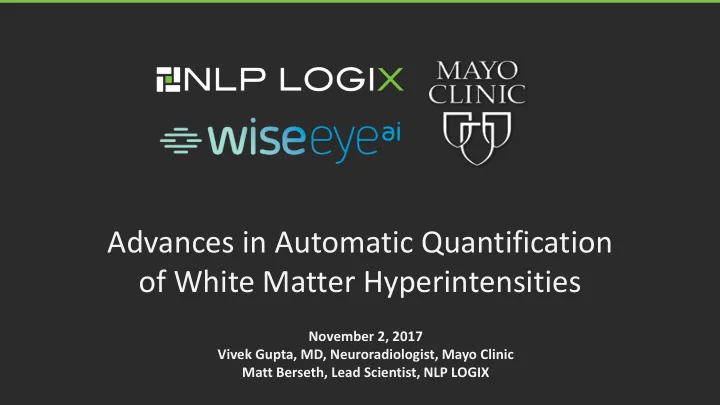

Advances in Automatic Quantification of White Matter Hyperintensities November 2, 2017 Vivek Gupta, MD, Neuroradiologist, Mayo Clinic Matt Berseth, Lead Scientist, NLP LOGIX
Topics White Matter Disease Clinical Importance of WMH Quantification WMH Automated Algorithms MICCAI WMH Challenge
White Matter Disease White matter hyperintensities (WMH, also known as leukoaraiosis), are widely observed in the ageing population The abnormal signal, explained by a change in the fat/water ratio, reflects injury to the white matter Multiple sclerosis and other demyelinating diseases primarily affect white matter leading to characteristic WMH Longitudinal segmentation of age-related white matter hyperintensities C.H. Sudreet al. / Medical Image Analysis 38 (2017) BohlegaS, Al ShubiliA, Edris A, AlreshaidA, AlkhairallahT, AlSousMW, Farah S, Abu-Amero KK. -CADASIL in Arabs: clinical and genetic findings. BMC Medical Genetics 2007, 8:67doi:10.1186/1471-2350-8-67, CC BY 2.0, https://commons.wikimedia.org/w/index.php?curid=3441739
Clinical Impact of WMH WMHs are common in patients with cardiovascular risk factors such as hypertension, diabetes; and cerebrovascular disease WMH’s are associated with increased risk of functional decline, dementia, and death 2016 2017 Quantitation and longitudinal monitoring of WMH is of major importance in clinical medicine, cerebrovascular research and drug trials in multiple sclerosis
Quantifying WMH Growing need for reliable quantification of WHM to better understand their diagnostic and prognostic value in both healthy and diseased populations Lesion size, location, total WMH burden and overall white matter volume Visual rating scales: Fazekas scale, Scheltensscale and the age-related white matter changes (ARWMC) scale BIANCA (Brain Intensity AbNormality Classification Algorithm): A new tool for automated segmentation of white matter hyperintensities
Quantification Challenges • Visual scales are seldom comparable (Scheltenset al. 1998) • Lack critical clinically important information about spatial distribution of WMH • Visual scales are not appropriate when examining longitudinal progression of WMH (Prinset al. 2004) • Show poor sensitivity to clinical group differences (Mantyla et al. 1997) • High intra-subject and inter-subject variability (van den Heuvel et al. 2006) Manual quantification of WMH areas is more reliable, but the processing involved is far too cumbersome and time consuming for practical utility Automatic Detection of White Matter Hyperintensities in HealthyAgingand Pathology Using Magnetic Resonance Imaging:AReview
Quantification Challenges Voxel-wise WMH maps can be used to quantitate and better understand relationship between WMH and specific symptoms Semi-automated voxel-based morphometry requires considerable manual processing and lack generalizability across different MRI hardware and scanning technique for widespread application Need – accurate, objective and automated method to quantitate and spatio-temporally map WMH with adaptive perpetual learning capability references
Algorithmic WMH Segmentation and Quantification
Automated WMH Algorithms ‘in - house’ algorithms Study or protocol specific Small sample sizes Not evaluated on publicly available data set references
BIANCA Automated Algorithm Multiple MRI protocols Key options references
BIANCA Requires retraining Automated Algorithm By protocol Multiple MRI protocols Adapted to each dataset Key options references
WMH Challenge Aim: Directly compare methods for automatic segmentation of WMH Many published techniques Issues: • Different ground truth • Different evaluation metrics • Different data sets
WMH Challenge – Reference Standard WMH manually segmented by Observer 1 (O1), then peer reviewed corrected by Observer 2 (O2) Binary masks created from annotations used as ground truth Currently gathering Observer 3 (O3) segmentations, estimate is inter-observer Dice of 0.8 Image: https://ww5.aievolution.com/hbm1701/index.cfm?do=abs.viewAbs&abs=1574
Deep, Multi-scale, Convolutional Network WMH Negative FC 400 FC 400 FC 200 WMH Positive
WMH Model Highlights Skull stripping using FSL 399,716 positive patches 550,000 negative patches Upsampled high-intensity negative FLAIR ReLU, Dropout in FC layers, Batch Norm No pooling, mini-batch size of 768 references
references
references
Example Auto-Segmented Scans references
Key Metrics in Automated Quantification • Total WMH Volume • Total # of Lesions • Localization of Lesions • Registration of WMH to atlas Longitudinal monitoring • Progression, Regression, Stability • New Lesions • Lesion Growth references
The Challenge of f Accurate Detection Initial One year later
The Problem of f Quantification and Longitudinal Monitoring Ten years ago Current
What next: • Additional training data • Additional validation • Deploy for clinical use
Thank you
Recommend
More recommend